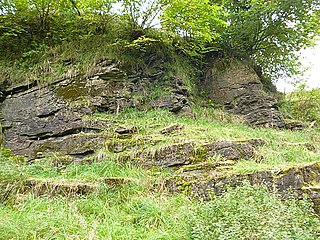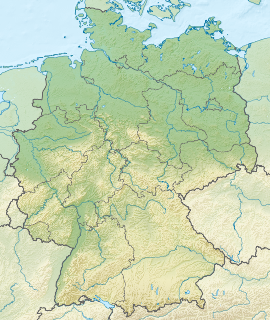 W
WThe Alston Formation is a geologic formation in England. It preserves fossils dating back to the Viséan to Serpukhovian stages of the Carboniferous period.
 W
WThe Ballagan Formation is a geologic formation in Scotland and England. It preserves fossils dating back to the early part of the Carboniferous period (Tournaisian–Visean).
 W
WCarboniferous Limestone is a collective term for the succession of limestones occurring widely throughout Great Britain and Ireland that were deposited during the Dinantian Epoch of the Carboniferous Period. These rocks formed between 363 and 325 million years ago. Within England and Wales, the entire limestone succession, which includes subordinate mudstones and some thin sandstones, is known as the Carboniferous Limestone Supergroup.
 W
WThe coal measures is a lithostratigraphical term for the coal-bearing part of the Upper Carboniferous System. In the United Kingdom, the Coal Measures Group consists of the Upper Coal Measures Formation, the Middle Coal Measures Formation and the Lower Coal Measures Formation. The group records the deposition of fluvio-deltaic sediments which consists mainly of clastic rocks interstratified with the beds of coal. In most places, the coal measures are underlain by coarser clastic sequences known as Millstone Grit, of Namurian age. The top of the coal measures may be marked by an unconformity, the overlying rocks being Permian or later in age. In some parts of Britain, however, the Coal Measures grade up into mainly coal-barren red beds of late Westphalian and possibly Stephanian age. Within the Pennine Basin these barren measures are now referred to as the Warwickshire Group, from the district where they achieve their thickest development.
 W
WThe Corona Formation is a geologic formation of the Carnian Alps at the border of Austria and Italy. It preserves fossils dating back to the Gzhelian stage of the Late Carboniferous period.
 W
WThe East Kirkton Limestone is a rock unit in the West Lothian Oil-Shale Formation in Scotland. It preserves fossils of the Carboniferous period. The limestone outcrops at East Kirkton Quarry.
 W
WThe Exmoor Group is a late Devonian to early Carboniferous lithostratigraphic group in southwest England whose outcrop extends from Croyde in north Devon east across Exmoor to Minehead in west Somerset. The group comprises the following formations the:Pilton Mudstone Formation Baggy Sandstones Formation Upcott Slates Formation Pickwell Down Sandstones Formation Morte Slates Formation Ilfracombe Slates Formation Hangman Sandstone Formation Lynton Formation
 W
WThe Gehrener Schichten is a geologic formation in Germany. The fluvial to lacustrine shales preserve fossils dating back to the Late Carboniferous period.
 W
WThe Holsworthy Group is a late Carboniferous lithostratigraphic group in north and east Cornwall and Devon in southwest England. The name is derived from the Devon town of Holsworthy. The Group comprises the Crackington, Bideford and Bude formations. In the Launceston area the group is represented by the Bealsmill Formation. It was formerly known as the Upper Culm Group.
 W
WHunts Bay Oolite is an oolitic carboniferous limestone geological formation found in the south Wales region. It is named after Hunts Bay on the Gower peninsula, south-south west of Bishopston, where a significant amount of the limestone forms the cliffs there.
 W
WThe Knipe Scar Limestone is a geologic formation in England. It preserves fossils dating back to the Carboniferous period.
 W
WThe Marros Group is the name given to a suite of rocks of Namurian age laid down during the Carboniferous Period in South Wales. These rocks were formerly known as the Millstone Grit Series but are now distinguished from the similar but geographically separate rock sequences of the Pennines and Peak District of northern England and northeast Wales by this new name.
 W
WMillstone Grit is the name given to any of a number of coarse-grained sandstones of Carboniferous age which occur in the British Isles. The name derives from its use in earlier times as a source of millstones for use principally in watermills. Geologists refer to the whole suite of rocks that encompass the individual limestone beds and the intervening mudstones as the Millstone Grit Group. The term Millstone Grit Series was formerly used to refer to the rocks now included within the Millstone Grit Group together with the underlying Edale Shale Group.
 W
WThe Ohlsbach Formation is a geologic formation in Germany. It preserves fossils dating back to the Gzhelian stage of the Late Carboniferous period.
 W
WThe Old Red Sandstone is an assemblage of rocks in the North Atlantic region largely of Devonian age. It extends in the east across Great Britain, Ireland and Norway, and in the west along the northeastern seaboard of North America. It also extends northwards into Greenland and Svalbard. These areas were a part of the ancient continent of Euramerica/Laurussia. In Britain it is a lithostratigraphic unit to which stratigraphers accord supergroup status and which is of considerable importance to early paleontology. For convenience the short version of the term, ORS is often used in literature on the subject. The term was coined to distinguish the sequence from the younger New Red Sandstone which also occurs widely throughout Britain.
 W
WThe Pembroke Limestone Group is a stratigraphic unit of Courceyan to Brigantian age found in southern Wales and northern Somerset. It forms part of the Carboniferous Limestone Supergroup.
 W
WThe Pennant Measures is the traditional name for a sequence of sedimentary rocks of the South Wales Coalfield. They were also referred to as the Upper Coal Measures and assigned to the Westphalian 'C' and Westphalian 'D' stages of the Carboniferous Period. The Pennant Measures were divided into the Lower Pennant Measures and the Upper Pennant Measures, differing from the underlying Middle and Lower Coal Measures in being principally of sandstone units – known collectively as the Pennant Sandstone – with mudstone being the subsidiary rock type. Numerous coal seams occur within the Pennant Measures though they are less common than in the underlying Coal Measures.
 W
WThe Teign Valley Group is a late Devonian to late/middle Carboniferous lithostratigraphic group in north Cornwall through Devon and into west Somerset in southwest England. The name is derived from the valley of the River Teign. The Group comprises the Barras Nose, Trambley Cove, Teign Chert and Dowhills Mudstone formations. It also includes the Brendon and St Mellion formations whose stratigraphical context is unclear since all known boundaries of these two unit are tectonic. The Brendon Formation slates extend from Tavistock west to Bodmin Moor. The St Mellion Formation sandstones, siltsones and mudstones are found from Holne northeastwards. The Teign Valley Group was formerly known as the Lower Culm Group or Lower Culm Measures.